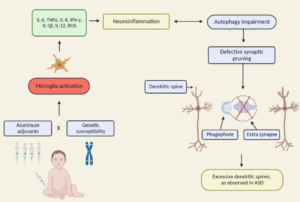Excerpt:
“Taken together these findings suggest deleterious effects on the cytoarchitecture by thimerosal and initiation of mitochondrial-mediated apoptosis.”
Excerpt:
“Vaccines, in several reports were found to be temporally followed by a new onset of autoimmune diseases. The same mechanisms that act in infectious invasion of the host, apply equally to the host response to vaccination. “
Excerpt:
“A higher percentage of the total Hg in the brain was in the form of inorganic Hg for the thimerosal-exposed monkeys (34% vs. 7%).”
Excerpt:
“Five of 11 patients studied were classified with definite mitochondrial respiratory chain disorder, suggesting that this might be one of the most common disorders associated with autism (5 of 69; 7.2%) and warranting further investigation.”
Excerpts:
“In summary, this study examined the validity of the phenomenon of regression using home videotape observations and provided support for parental report of regression in autism.”
“Conclusion This study validates the existence of early autistic regression.”
Excerpt: “Because this neuroinflammatory process appears to be associated with an ongoing and chronic mechanism of CNS dysfunction, potential therapeutic interventions should focus on the control of its detrimental effects and thereby eventually modify the clinical course of autism.”
may contribute to the development and clinical manifestation of autism.
Excerpt:
“The author reviews the available survey literature and finds evidence of large increases in prevalence in both the United States and the United Kingdom that cannot be explained by changes in diagnostic criteria or improvements in case ascertainment.”
Abstract
Thimerosol is an antiseptic containing 49.5% ethyl mercury that has been used for years as a preservative in many infant vaccines and in flu vaccines. Environmental methyl mercury has been shown to be highly neurotoxic, especially to the developing brain. Because mercury has a high affinity for thiol (sulfhydryl (-SH)) groups, the thiol-containing antioxidant, glutathione (GSH), provides the major intracellular defense against mercury-induced neurotoxicity. Cultured neuroblastoma cells were found to have lower levels of GSH and increased sensitivity to thimerosol toxicity compared to glioblastoma cells that have higher basal levels of intracellular GSH. Thimerosal-induced cytotoxicity was associated with depletion of intracellular GSH in both cell lines. Pretreatment with 100 microM glutathione ethyl ester or N-acetylcysteine (NAC), but not methionine, resulted in a significant increase in intracellular GSH in both cell types. Further, pretreatment of the cells with glutathione ethyl ester or NAC prevented cytotoxicity with exposure to 15 microM Thimerosal. Although Thimerosal has been recently removed from most children’s vaccines, it is still present in flu vaccines given to pregnant women, the elderly, and to children in developing countries. The potential protective effect of GSH or NAC against mercury toxicity warrants further research as possible adjunct therapy to individuals still receiving Thimerosal-containing vaccinations.
Excerpts:
“The association of epilepsy, autism spectrum disorders (ASD), and intellectual disability (ID) is well recognized.”
“CONCLUSIONS:
MMR vaccination was associated with a transient increased rate of febrile seizures…”
